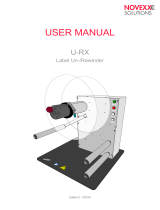
2 • vacon Introduction
Tel. +358 (0)201 2121 • Fax +358 (0)201 212 205
INDEX
1. Introduction........................................................................................................................3
2. Function / terminal programming methods .......................................................................4
2.1 Defining an input for a certain function on keypad ................................................................. 6
3. Winder application control basics ......................................................................................7
3.1 Starting direction ..................................................................................................................... 7
3.2 References and actual values..................................................................................................8
4. Control I/O........................................................................................................................ 10
5. Winder Application – Parameter lists............................................................................... 11
5.1 Monitoring values (Control keypad: menu M1) ..................................................................... 11
5.2 Basic parameters (Control keypad: Menu M2 Æ G2.1)......................................................... 15
5.3 Input signals (Control keypad: Menu M2 Æ G2.2)................................................................. 16
5.4 Output signals (Control keypad: Menu M2 Æ G2.3) .............................................................. 20
5.5 Drive control parameters (Control keypad: Menu M2 Æ G2.4) ............................................22
5.6 Prohibit frequency parameters (Control keypad: Menu M2 Æ G2.5) ................................... 22
5.7 Motor control parameters (Control keypad: Menu M2 Æ G2.6) ........................................... 23
5.8
Protections (Control keypad: Menu M2 Æ G2.7)................................................................... 24
5.9 Autorestart parameters (Control keypad: Menu M2 Æ G2.8)............................................... 25
5.10 Winder Parameters (Control keypad: Menu M2 Æ G2.9)...................................................... 26
5.11 Keypad control (Control keypad: Menu M3) .......................................................................... 27
5.12 System menu (Control keypad: M6) ...................................................................................... 28
5.13 Expander boards (Control keypad: Menu M7)....................................................................... 28
6. Description of parameters ............................................................................................... 29
6.1 BASIC PARAMETERS .............................................................................................................29
6.2 INPUT SIGNALS......................................................................................................................31
6.3 LINE REFERENCES AND ACTUAL SIGNAL SELECTIONS .................................................... 36
6.4 OUTPUT SIGNALS ..................................................................................................................39
6.5 DRIVE CONTROL .................................................................................................................... 44
6.6 PROHIBIT FREQUENCIES ......................................................................................................48
6.7 MOTOR CONTROL ..................................................................................................................49
6.8 CLOSED LOOP PARAMETERS................................................................................................53
6.9 PROTECTIONS........................................................................................................................ 55
6.10 AUTO RESTART PARAMETERS.............................................................................................. 63
6.11 WINDER PARAMETERS.......................................................................................................... 66
6.12 SETTING PROFIBUS............................................................................................................... 75
6.13 KEYPAD CONTROL PARAMETERS ........................................................................................ 76
7. Control signal logic in Winder Application ....................................................................... 77
8. Fault codes....................................................................................................................... 78





















